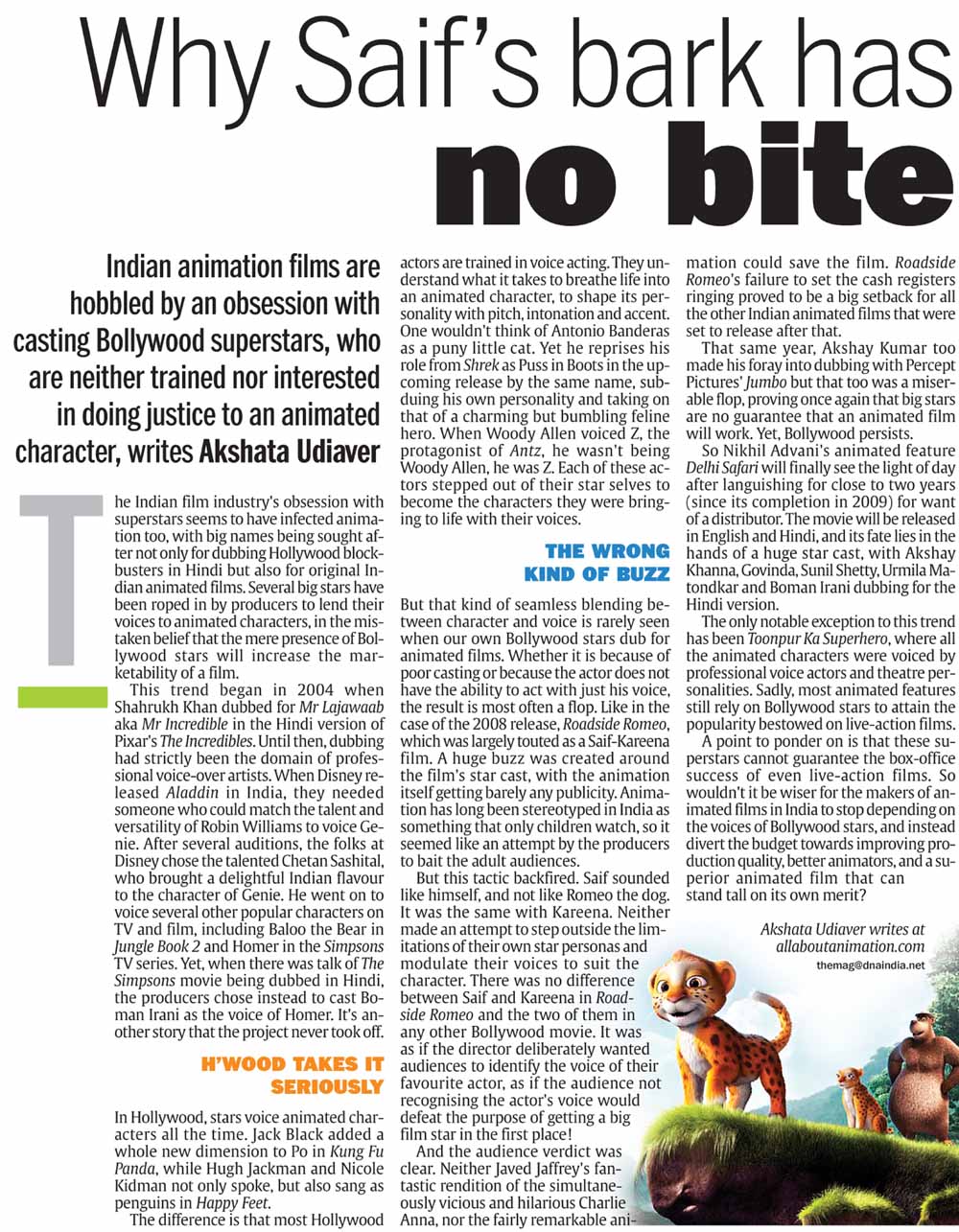* This article was originally published in DNA Sunday Mag (pg. 15) on 31st July 2011
– Read it ONLINE / Download PDF *
Indian animation films are hobbled by an obsession with casting Bollywood superstars, who are neither trained nor interested in doing justice to an animated character, writes Akshata Udiaver
The Indian film industry’s obsession with superstars seems to have infected animation too, with big names being sought after not only for dubbing Hollywood blockbusters in Hindi but also for original Indian animated films.
Several big stars have been roped in by producers to lend their voices to animated characters, in the mistaken belief that the mere presence of Bollywood stars will increase the marketability of a film.
This trend began in 2004 when Shahrukh Khan dubbed for Mr Lajawaab aka Mr Incredible in the Hindi version of Pixar’s The Incredibles. Until then, dubbing had strictly been the domain of professional voice-over artists. When Disney released Aladdin in India, they needed someone who could match the talent and versatility of Robin Williams to voice Genie.
After several auditions, the folks at Disney chose the talented Chetan Sashital, who brought a delightful Indian flavour to the character of Genie. He went on to voice several other popular characters on TV and film, including Baloo the Bear in Jungle Book 2 and Homer in the Simpsons TV series. Yet, when there was talk of The Simpsons movie being dubbed in Hindi, the producers chose instead to cast Boman Irani as the voice of Homer. It’s another story that the project never took off.
H’wood takes it seriously
In Hollywood, stars voice animated characters all the time. Jack Black added a whole new dimension to Po in Kung Fu Panda, while Hugh Jackman and Nicole Kidman not only spoke, but also sang as penguins in Happy Feet.
The difference is that most Hollywood actors are trained in voice acting. They understand what it takes to breathe life into an animated character, to shape its personality with pitch, intonation and accent.
One wouldn’t think of Antonio Banderas as a puny little cat. Yet he reprises his role from Shrek as Puss in Boots in the upcoming release by the same name, subduing his own personality and taking on that of a charming but bumbling feline hero.
When Woody Allen voiced Z, the protagonist of Antz, he wasn’t being Woody Allen, he was Z. Each of these actors stepped out of their star selves to become the characters they were bringing to life with their voices.
The wrong kind of buzz
But that kind of seamless blending between character and voice is rarely seen when our own Bollywood stars dub for animated films. Whether it is because of poor casting or because the actor does not have the ability to act with just his voice, the result is most often a flop.
Like in the case of the 2008 release, Roadside Romeo, which was largely touted as a Saif-Kareena film. A huge buzz was created around the film’s star cast, with the animation itself getting barely any publicity. Animation has long been stereotyped in India as something that only children watch, so it seemed like an attempt by the producers to bait the adult audiences.
But this tactic backfired. Saif sounded like himself, and not like Romeo the dog. It was the same with Kareena. Neither made an attempt to step outside the limitations of their own star personas and modulate their voices to suit the character.
There was no difference between Saif and Kareena in Roadside Romeoand the two of them in any other Bollywood movie. It was as if the director deliberately wanted audiences to identify the voice of their favourite actor, as if the audience not recognising the actor’s voice would defeat the purpose of getting a big film star in the first place!
And the audience verdict was clear. Neither Javed Jaffrey’s fantastic rendition of the simultaneously vicious and hilarious Charlie Anna, nor the fairly remarkable animation could save the film. Roadside Romeo’s failure to set the cash registers ringing proved to be a big setback for all the other Indian animated films that were set to release after that.
That same year, Akshay Kumar too made his foray into dubbing with Percept Pictures’ Jumbo but that too was a miserable flop, proving once again that big stars are no guarantee that an animated film will work. Yet, Bollywood persists.
So Nikhil Advani’s animated feature Delhi Safari will finally see the light of day after languishing for close to two years (since its completion in 2009) for want of a distributor. The movie will be released in English and Hindi, and its fate lies in the hands of a huge star cast, with Akshay Khanna, Govinda, Sunil Shetty, Urmila Matondkar and Boman Irani dubbing for the Hindi version.
The only notable exception to this trend has been Toonpur Ka Superhero, where all the animated characters were voiced by professional voice actors and theatre personalities. Sadly, most animated features still rely on Bollywood stars to attain the popularity bestowed on live-action films.
A point to ponder on is that these superstars cannot guarantee the box-office success of even live-action films. So wouldn’t it be wiser for the makers of animated films in India to stop depending on the voices of Bollywood stars, and instead divert the budget towards improving production quality, better animators, and a superior animated film that can stand tall on its own merit?

